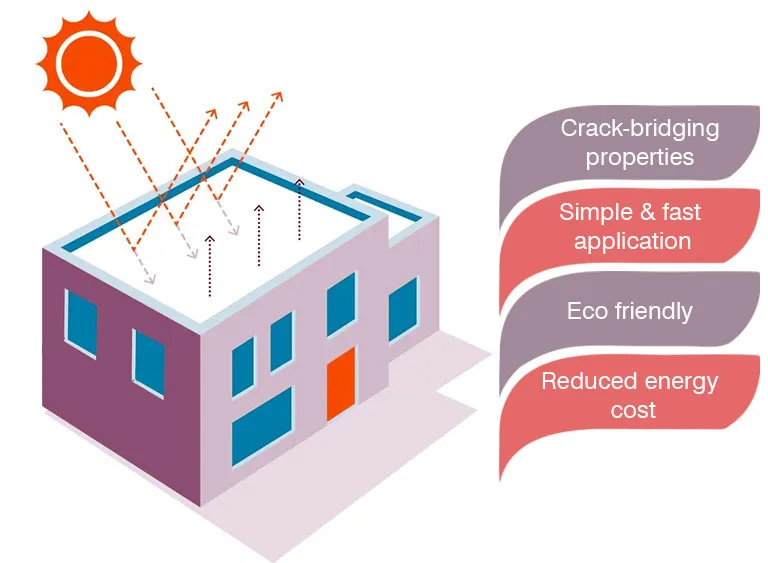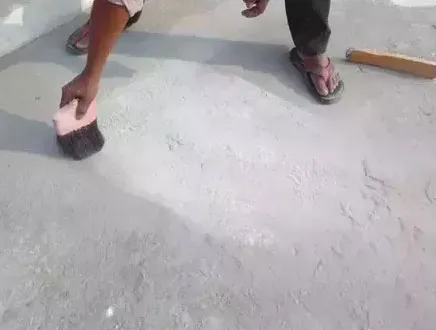Cool roof coatings are white or special reflective pigments that reflect sunlight. They are like very thick paints that can protect the roof surface from ultra-violet (UV) light and chemical damage, and some offer water protection and restorative features. Cool roof coatings deliver higher solar reflectance and higher thermal emittance than standard designed roofing coats. Standard or dark roofs can reach temperatures of 150°F or more in the summer sun. A roof with a cool coating under the same conditions could stay more than 50°F cooler and save energy and money. Highly reflective and anti-fungal by nature, the coating is easy to clean and offers excellent value for money. It is easy to apply via brush or rollers and offers excellent water resistance and superior crack bridging.

Advantages of cool roof coating
- Minimum surface preparation needed
- Available as ready to use
- High solar reflectance index (SRI) indicates high degree of cooling effect
- Crack-bridging
- High resistance to chloride penetration
- Algae and fungi resistant
- Highly flexible and Vapour permeable
- Simple and fast application
- Excellent adhesion to concrete, Ultra violet rays and weather resistant
- Reduces the surface temperature of roofs by 50% compared with a dark coloured covering
- Reduced energy cost
- Eco friendly
Cool roof coating products
Acrylic based cool coats – These contain cross-linking polymers, special glass microfibers, pigments and advanced antifungal additives that provide long lasting tough waterproofing membrane. The high Solar Reflective Index of the membrane serves as a heat reflective surface and reduces heat ingress keeping the interior of the building cooler.
Fiber filled liquid cool coats – These are a ready-to-use waterproofing, white product, with high solar reflectance and thermal index (SRI) of 105, for external applications made from synthetic resins in water dispersion, and when dry forms a continuous, flexible waterproofing membrane.
Polymer cool coats – These are water-based white coloured emulsion consisting of polymers and specially designed hollow “microspheres”, less than 100 microns in diameter with non conductive properties. These microspheres collectively act as thermal insulation blankets covering the structure effectively reflecting solar radiation back into the atmosphere.
PUD hybrid cool coats – These are water based, high solids, PUD hybrid coats that contains both reflection and nano insulation pigments for best in class heat protection. These are powered with micro-fibres for excellent waterproofing & crack resistance.
Single-ply cool coats – These are prefabricated sheets rolled onto the roof and attached with mechanical fasteners, adhered with chemical adhesives
Modified bitumen cool coats – They have one or more layers of plastic or rubber material with reinforcing fabrics, and are surfaced with mineral granules or a smooth finish.
Spray polyurethane cool coats – These are formed by mixing two liquid chemicals together that react and expand to form one solid piece that adheres to the roof. Foams are highly susceptible to mechanical, moisture, and UV damage, and rely on a protective coating.
Applications method of cool roof coating
Substrate preparation – All dust, loose and friable materials and glaze or varnish of tiles must be completely removed by mechanical means. Existing coatings/ membranes have to be inspected, cleaned and mechanically ground to achieve a sound, gripping substrate.

Repair and reinforce – Patch and repair cracks, blisters and other problem areas using roof patch following label directions. Blisters in previous coatings may be opened but these areas must be allowed to dry-out completely. Blisters in the roofing ply should be left alone unless likely to break. Caulk and reinforce open seams, roof penetrations, cracks, and tears. These are potential leak points so work carefully and thoroughly. Use fabric to build flashings around roof edges or roof penetrations, and to reinforce various coating repairs.

Apply coating – Apply coating when the roof is dry and the sealant has set. You will need a heavy-duty frame, ½-inch paint roller for spreading coating on the roof or 1-1/4-inch roller for dipping in pail, and a foot extension pole. Use a roller with base coats and emulsions. Map out your roof and make each pail fill that area.

The final check – Check out the product details for recommended coverage Use a stiff paint brush for applying Crack & Joint Sealant. Topcoats should always be applied in a very thick coat. Two thin coats or one heavier coat may also be used to achieve desired result.

Application areas of cool roof coating
- Roof slabs(flat and sloped)
- Asbestos and lime terraced roofs
- PVC water tanks
- Sintex tanks
- Oil Storage Tanks
- External walls and balconies
- Old or new sheets and RCC roofs
- Factories
- Commercial and residential buildings
Image Source: excelcoatings.co.in, fairmate.com, mapei.com


